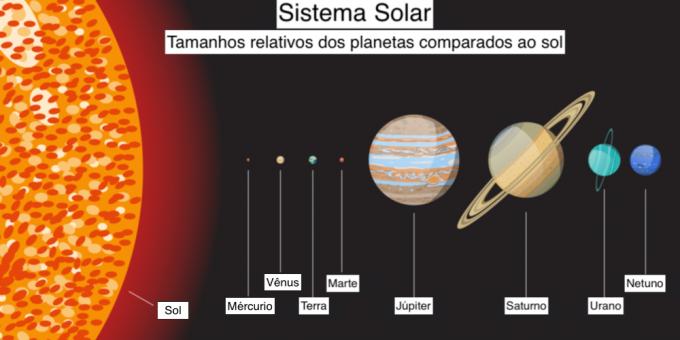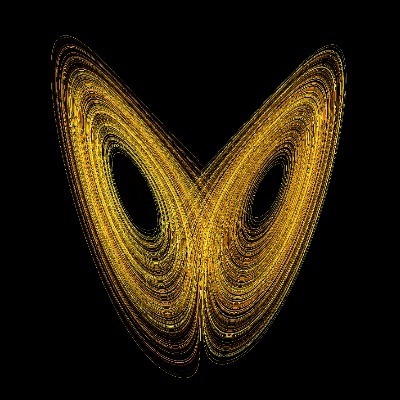the sun is the onlystar of our solar system. Formed by a sphere of incandescent gas, the Sun is a source of light and heat for the Earth, without which the necessary conditions for life would not exist.
Located in the center of the solar system, the Sun is responsible for the gravitational interaction of the 8 planets and other celestial bodies around it. Its mass represents 99.8% of the entire mass of the solar system.
 The Sun is the central star of our solar system.
The Sun is the central star of our solar system.
THE energy produced by the Sun is the result of thermo nuclear reactions at its core. These reactions happen from the fusion of hydrogen nuclei to form a helium nucleus.
The composition of the Sun is, above all, of hydrogen and helium, which correspond respectively to 71% and 27% of its mass. Other elements that are present in its composition are: iron nickel and oxygen.
Sun Characteristics
The Sun is a star composed of ionized gases and with very high density, temperature and pressure conditions. Discover the characteristics of the biggest star in the solar system:
size of the sun
The Sun is the largest star in the solar system, its diameter corresponds to 109 times the diameter of planet Earth and its mass corresponds to 99.8% of the entire solar system.
The Sun is so big that within its circumferences they would fit 1.3 million planets Earth. Its mass corresponds to 333,000 times the mass of the Earth.
- Sun Mass = 1.989 x 1030 kg
- Sun's radius = 695,500 km
Despite being a very large star in our solar system, the Sun is considered a medium sized star in the universe, that is, there are much bigger stars.
 Graphic representation of the relative size of the Sun and planets in the Solar System.
Graphic representation of the relative size of the Sun and planets in the Solar System.
Learn more about solar system.
Sun temperature
The temperature of the Sun varies according to the layers, but its core has a temperature of approximately 15,000,000 °C. In the layer that we can see with the naked eye of the Earth, the photosphere, the temperature is about 6,000 °C.
Distance from Earth
The Sun is the closest star to Earth, it is at 150 million kilometers of our planet.
The energy produced by the Sun takes about 50 million years to reach the Earth's surface. Light, on the other hand, reaches the Earth's surface in just 8 minutes.
sun age
The Sun has approximately 4.6 billion years and is the result of the collapse of a molecular cloud. It is estimated that in about 5 million years the Sun will become a red giant and will likely engulf the Earth.
Research indicates that after the red giant stage, the Sun will lose mass and collapse, becoming a white dwarf.
Learn more about stars.
physical structure of the sun
The Sun is formed by six layers: core, radioactive zone, convective zone, photosphere, chromosphere and corona. The temperature, pressure and density conditions get higher as you get closer to the core.
- Core: the core is the central part of the Sun, where energy is produced through nuclear fusions;
- Radioactive zone: in this layer, the energy produced in the core is propagated by irradiation, that is, heat transfer takes place by electromagnetic waves;
- Convective zone: in this layer, energy is propagated by convection, that is, heat transfer takes place by circular currents that form as a result of different temperatures;
- Photosphere: this is the visible layer from Earth, its temperature is about 6,000 °C. It is in the photosphere that sunspots are formed, which are colder and darker regions.
- Chromosphere: the chromosphere is a thin layer that is not visible except in the case of eclipses. Its thickness is about 10,000 km and its temperature ranges from 4,000 °C to 40,000 °C.
- Crown: the corona is the outermost layer and can only be seen in total eclipses. Its temperature can reach 1 million degrees Celsius and it is from this layer that the solar winds come out.
 Graphic representation of the physical structure of the sun.
Graphic representation of the physical structure of the sun.
How does the sun produce energy?
The Sun produces energy from the fusion of 4 hydrogen protons in 1 helium nucleus. Every 1 second, the sun transforms 600 million tons of hydrogen into 596 million tons of helium and 4 million tons of energy.
The sun has enough hydrogen to produce energy for billions of years, but over time the concentration of helium in the sun will increase, which will make the sun brighter.
It is estimated that in the next 1.1 billion years, the Sun will be 10% brighter and in 3.5 billion years, 40% brighter. At this stage, the oceans will be completely dry.
When the Sun has used up all the hydrogen in its core, it will become a red giant and keep itself alive by burning helium. When this substance runs out, the Sun will begin to die.
sunspots
Sunspots are the darkest parts that can be seen with the naked eye of the Earth. They are formed by intense magnetic fields that cause a cooling, making this area cooler than its surroundings.
This phenomenon happens in the photosphere and can last for days or weeks. The spots are made up of two parts: the umbra, which is in the center and is darker; and the penumbra, which is around the umbra and is less dark.
 Sunspots captured by NASA.
Sunspots captured by NASA.
solar winds
Solar winds are continuous streams of particles, mainly protons and electrons, which are emitted from the corona, the last layer of the Sun. The speed of these winds can reach 800 km/s.
Solar winds are responsible for the loss of mass of the Sun and the aurora borealis in the northern hemisphere and the aurora australis in the southern hemisphere.
 Graphic representation of solar winds.
Graphic representation of solar winds.
Understand more about the Northern Lights.
Curiosities about the Sun
- The Sun produces 4 x 1023 kilowatts of power per second;
- The Sun rotates around its own axis in approximately 25 days;
- The energy produced in the Sun's core takes 1.5 million years to reach the photosphere;
- The pressure in the Sun's core is 340 billion times the atmospheric pressure on Earth;
- The amount of energy produced by the Sun in one second is the equivalent of burning 7.5 x 1020 liters of gasoline per minute or 10 million times the planet's oil production in a year;
- If the energy produced by the Sun in one second were stored, it would be enough to supply Brazil for the next 9 million years;
- Besides the Sun, it is estimated that there are about 200 billion stars in the Milky Way alone;
- In a second, the sun produces more energy than has ever been used in all of human civilization.
See also the meaning of galaxy, universe and astronomy.


